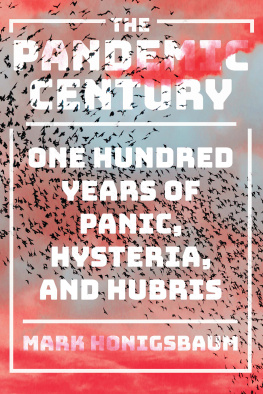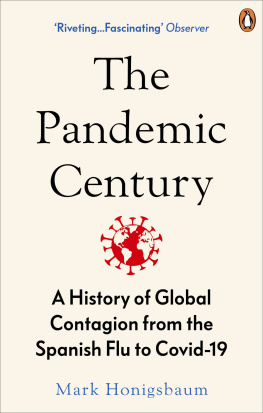Contents

THE
PANDEMIC
CENTURY
ALSO BY MARK HONIGSBAUM
A History of the Great Influenza Pandemics:
Death, Panic and Hysteria, 18301920
Living with Enza:
The Forgotten Story of Britain and the Great Flu Pandemic of 1918
The Fever Trail:
In Search of the Cure for Malaria
Valverdes Gold:
In Search of the Last Great Inca Treasure
THE
PANDEMIC
CENTURY
ONE HUNDRED YEARS OF
PANIC, HYSTERIA,
AND HUBRIS
MARK HONIGSBAUM

W. W. NORTON & COMPANY
Independent Publishers Since 1923
New York | London
Copyright 2019 by Mark Honigsbaum
All rights reserved
First Edition
For information about permission to reproduce selections from this book, write to
Permissions, W. W. Norton & Company, Inc., 500 Fifth Avenue, New York, NY 10110
For information about special discounts for bulk purchases, please contact
W. W. Norton Special Sales at specialsales@wwnorton.com or 800-233-4830
Book design by Chris Welch
Production manager: Anna Oler
The Library of Congress has cataloged the printed edition as follows:
Names: Honigsbaum, Mark, author.
Title: The pandemic century : one hundred years of panic, hysteria, and hubris /
Mark Honigsbaum.
Description: First edition. | New York : W. W. Norton & Company, [2019] |
Includes bibliographical references and index.
Identifiers: LCCN 2018048424 | ISBN 9780393254754 (hardcover)
Subjects: | MESH: Pandemicshistory | History, 20th Century | History, 21st Century
Classification: LCC RA650.5 | NLM WA 11.1 | DDC 614.4/90904dc23
LC record available at https://lccn.loc.gov/2018048424
ISBN 9780393254761 (ebook)
W. W. Norton & Company, Inc., 500 Fifth Avenue, New York, N.Y. 10110
www.wwnorton.com
W. W. Norton & Company Ltd., 15 Carlisle Street, London W1D 3BS
FOR MARY-LEE

Everybody knows that pestilences have a way of recurring in the world; yet somehow we find it hard to believe in ones that crash down on our heads from a blue sky. There have been as many plagues as wars in history; yet plagues and wars always take people by surprise.
ALBERT CAMUS, The Plague

S harks never attack bathers in the temperate waters of the North Atlantic. Nor can a shark sever a swimmers leg with a single bite. Thats what most shark experts thought in the blisteringly hot summer of 1916 as New Yorkers and Philadelphians flocked to the beaches of northern New Jersey in search of relief from the sweltering inland temperatures. That same summer the East Coast had been gripped by a polio epidemic, leading to the posting of warnings about the risk of catching infantile paralysis at municipal pools. The Jersey shore was considered a predator-free zone, however.
The danger of being attacked by a shark, declared Frederic Lucas, director of the American Museum of Natural History in July 1916, is infinitely less than that of being struck by lightning and... there is practically no danger of an attack from a shark about our coasts. As proof, Lucas pointed to the reward of $500 that had been offered by the millionaire banker Hermann Oerlichs for an authenticated case of a man having being attacked by a shark in temperate waters [in the United States, north of Cape Hatteras, North Carolina]a sum that had gone unclaimed since Oerlichs had posted the challenge in the New York Sun in 1891.
But Oerlichs and Lucas were wrong, and so were Dr. Henry Fowler and Dr. Henry Skinner, the curators of Philadelphias Academy of Natural Science who had categorically stated, also in 1916, that a shark lacked the power to sever a mans leg. The first exception to these known facts had come on the evening of July 1, 1916, when Charles Epting Vansant, a wealthy young broker holidaying in New Jersey with his wife and family, decided to go for a predinner swim near his hotel at Beach Haven. A graduate of the University of Pennsylvanias class of 1914, Vansant, or Van to his chums, was a scion of one of the oldest families in the countryDutch immigrants who had settled in the United States in 1647and famed for his athleticism. If he had any concerns about entering the cool Atlantic waters that evening, they would have been offset by the familiar sight of the beach lifeguard, Alexander Ott, a member of the American Olympic swimming team, and a friendly Chesapeake Bay retriever that ran up to him as he slid into the surf. In the fashion of young Edwardian men of the time, Vansant swam straight out beyond the lifelines, before turning to tread water and call to the dog. By now his father, Dr. Vansant, and his sister, Louise, had arrived on the beach and were admiring his form from the lifeguard station. Much to their amusement, the hound refused to follow. Moments later, the reason became apparenta black fin appeared in the water, bearing down on Vansant from the east. Frantically, his father waved for his son to swim to shore, but Vansant spotted the danger too late and when he was fifty yards from the beach he felt a sudden tug and an agonizing pain. As the sea around him turned the color of wine, Vansant reached down to discover that his left leg was gone, severed neatly at the thigh bone.
By now Ott was at his side and dragging him through the water to the safety of the Engelside Hotel where his father desperately tried to stem the bleeding. But it was no usethe wound was too deepand to his father and young wifes horror Vansant died then and there, the first known victim of a shark attack in the North Atlantic. From that moment on, neither would be able to look at Jerseys Atlantic seaboard without imagining the jaws lurking beneath the surface.
It makes little difference that sightings of great whites and other large sharks in the North Atlantic are rare and attacks on swimmers rarer still. Beachgoers now know better than to swim too far from shore, and should they become blas about the risks and dismissive of the menace, there is always a rerun of Jaws or an episode of Discovery Channels Shark Week to set them straight. The result is that many children and a fair number of adults are now terrified of playing in the surf, and even those brave enough to venture beyond the breakers know to keep a wary eye on the horizon for the telltale sight of a dorsal fin.

AT FIRST GLANCE, the New Jersey shark attacks would seem to have little to do with the Ebola epidemic that engulfed West Africa in 2014 or the Zika epidemic that broke out in Brazil the following year, but they do, for just as in the summer of 1916 most naturalists could not conceive of a shark attack in the cool waters of the North Atlantic, so in the summer of 2014 most infectious disease experts could not imagine that Ebola, a virus previously confined to remote forested regions of Central Africa, might spark an epidemic in a major city in Sierra Leone or Liberia, much less cross the Atlantic to threaten citizens of Europe or the United States. But that is precisely what happened when, shortly before January 2014, Ebola emerged from an unknown animal reservoir and infected a two-year-old boy in the village of Meliandou, in southeastern Guinea, from whence the virus traveled by road to Conakry, Freetown, and Monrovia, and onward by air to Brussels, London, Madrid, New York, and Dallas.










